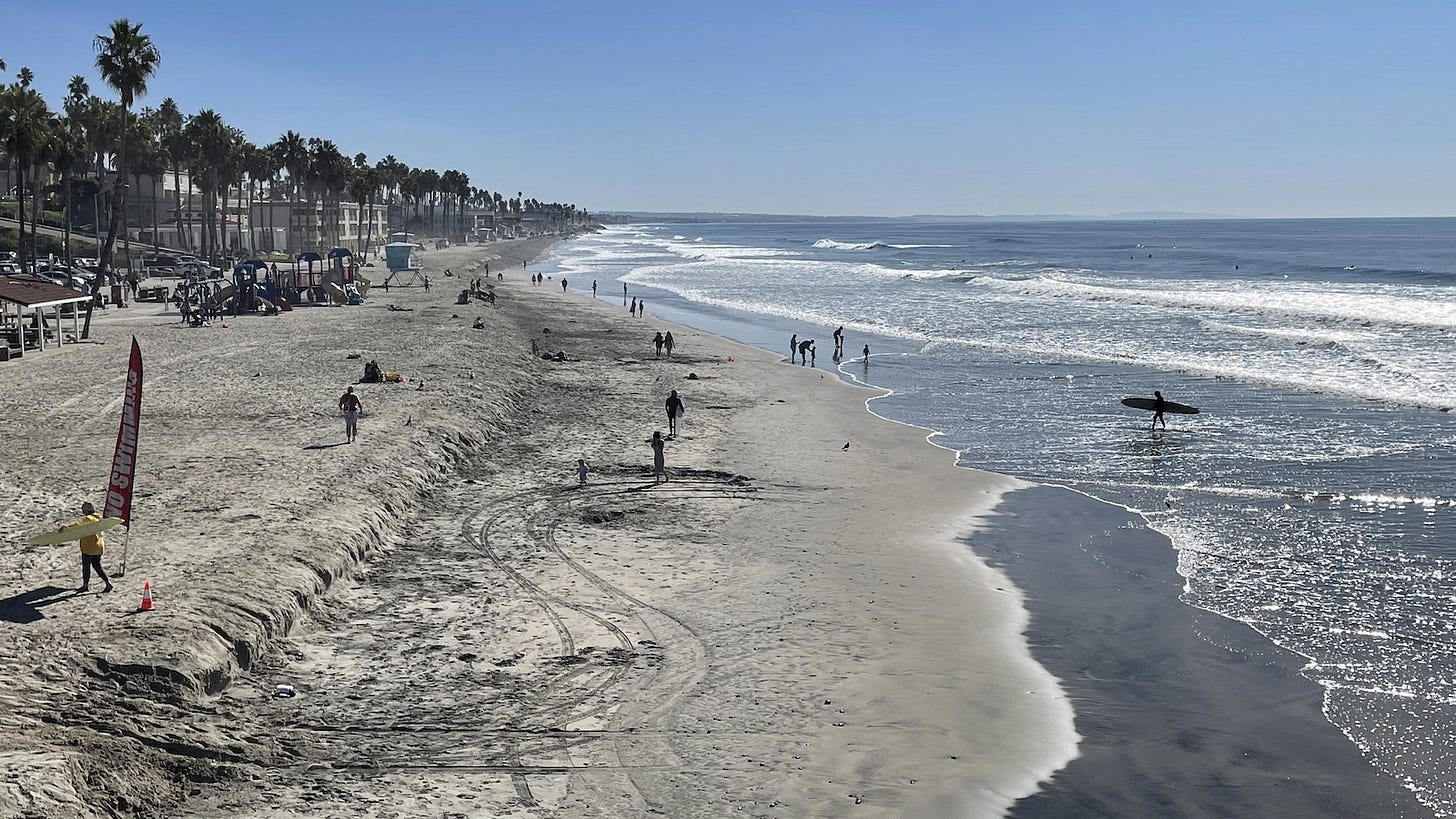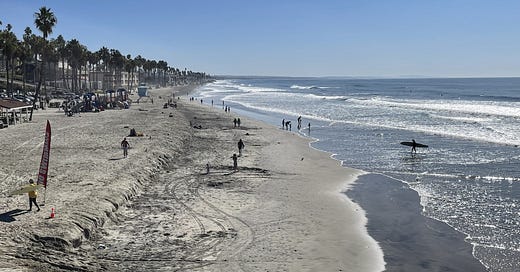Oceanside’s RE:BEACH gets SANDAG backing
Innovative pilot project becomes San Diego’s testbed for restoring sand and reshaping beach management across the coast

OCEANSIDE — The city’s aggressive and innovative RE:BEACH pilot program received the backing from the San Diego Association of Governments on June 5.
The SANDAG Shoreline Preservation Working Group (SPWG) selected the Oceanside’s RE:BEACH project as the region’s representative pilot project using innovative sand retention techniques to restore beaches. The City Council selected International Coastal Management of Australia and its “living speed bumps” concept, consisting of two artificial headlands and an offshore reef, in January 2024 as part of an international competition.
According to a press release from the city, the designation fulfills a key goal identified in the 2001 SANDAG Regional Sand Retention Strategy. With this designation, SANDAG will incorporate RE:BEACH into future updates of its shoreline policy and planning documents, collaborate with the city during the environmental compliance process to identify impacts and mitigation for the RE:BEACH project, support the city of Oceanside with its efforts to seek construction funding, and align the implementation of SANDAG’s third Regional Beach Sand Project (RBSP III) and RE:BEACH.
However, SANDAG is not responsible for the funding or construction of the pilot project.
“The design is exciting,” said Councilman Eric Joyce, who sits on the shoreline group. “We want to build a state-of-the-art, science-based system that all our coastal systems can use. We recognize millions of people rely on access to the ocean for their wellbeing, and this is critical for that to be an accessible resource in Oceanside and beyond.”
The project has moved forward as the city approved GHD Inc. in 2023 to oversee Phase 2, which focuses on locating sand sources, engineering design and regulatory coordination. On Dec. 18, 2024, the council approved an additional $700,000 for GHD’s work.
RE:BEACH also received a $1.835 million grant from the California Coastal Commission in April to support baseline environmental monitoring and modeling. Also, the city requested a $21.25 million grant from the California Department of Parks and Recreation’s Division of Boating and Waterways’ Public Beach Restoration Program, according to DredgeWire.
The city would contribute a 15% match, or $3.75 million, per reports. The grant would cover costs to dredge 900,000 cubic yards of sand from offshore deposits, more than twice pumped from Oceanside Harbor, DredgeWire reported. The sand would be pumped onto depleted beaches.
The pilot project, meanwhile, stretches from Tyson Street Park to Wisconsin Avenue and the city aims to break ground in 2026. The project’s location predominantly experiences northern sand movement away from down-shore cities based on data from William O’Reilly of Scripps Institution of Oceanography, per SANDAG.
As for SANDAG, the SPWG approved the designation based on RE:BEACH’s potential to inform the whole region about responsible sand retention. Group members recognized Oceanside’s pilot project as an innovative solution to coastal management, an issue that has historically struggled to maintain sandy beaches despite past nourishment efforts.
“We are proud that RE:BEACH will deliver a wide, sandy beach that Oceanside’s residents and our region’s beachgoers will enjoy in just a few years,” Oceanside City Manager Jonathan Borrego added. “This affirms our vision that RE:BEACH will benefit the entire region. We are grateful to SANDAG for helping develop and establish partnerships with our neighboring cities to learn together from this important pilot.”
The press release states the pilot project represents a bold, science-driven approach to address the chronic coastal erosion and limited sediment supply issues in Oceanside. The project includes the design and construction of a multi-purpose offshore artificial reef and two headlands, supported by nearshore and onshore beach nourishment.
The SPWG decision builds on recent momentum to update regional sediment transport knowledge. In 2023, the SPWG formed a Sediment Management Technical Taskforce (SMTT) to update the understanding of how sediment moves within the Oceanside Littoral Cell.
For more than one year, the SMTT-Oceanside Littoral Cell met with key researchers from Scripps Institution of Oceanography and UC Irvine, highlighting state-of-the-art research and observations on sediment dynamics. Topics ranged from existing regional shoreline monitoring programs, current understanding of how sediment moves within the littoral cells, lagoon inlet maintenance and challenges, and a review of the existing SANDAG Shoreline Policy documents.
“What we learn from RE:BEACH could transform the methods on how we manage our dynamic beaches across the region,” said Oceanside Coastal Zone Administrator Jayme Timberlake. “As the region’s pilot project, it offers a unique opportunity to share insights on both the project development process and implementation aspects of the novel concept design with all of San Diego’s coastal communities.”
With the selection, SANDAG will incorporate RE:BEACH into future updates of its shoreline policy and planning documents. Updates to SANDAG’s shoreline policy documents would be brought to the SPWG members for review and to seek recommendations for approval by the Regional Planning Committee and SANDAG Board of Directors.
City leaders, along with residents, have pointed to the urgency for the city and state to address Oceanside’s receding shoreline. Over the past several decades, sand has been lost due to the change in the currents from the marina at Camp Pendleton and Oceanside Harbor.
In addition, the beach is a pillar for the city’s tourism industry. In 2023, tourism accounted for $589 million in spending, with tax revenue topping $43 million (city and state), according to Visit Oceanside.
In 2024, visitor spending increased 6% to $625 million with roughly 70% of spending was on non-lodging items. Tourism accounted for $26 million in tax revenue for the city in 2024, a 6% increase over 2023, and more than 4,000 jobs, Visit Oceanside reported.
Follow North County Pipeline on Instagram, Facebook, X and Reddit. Send story ideas and tips to ncpipeline760@gmail.com.




